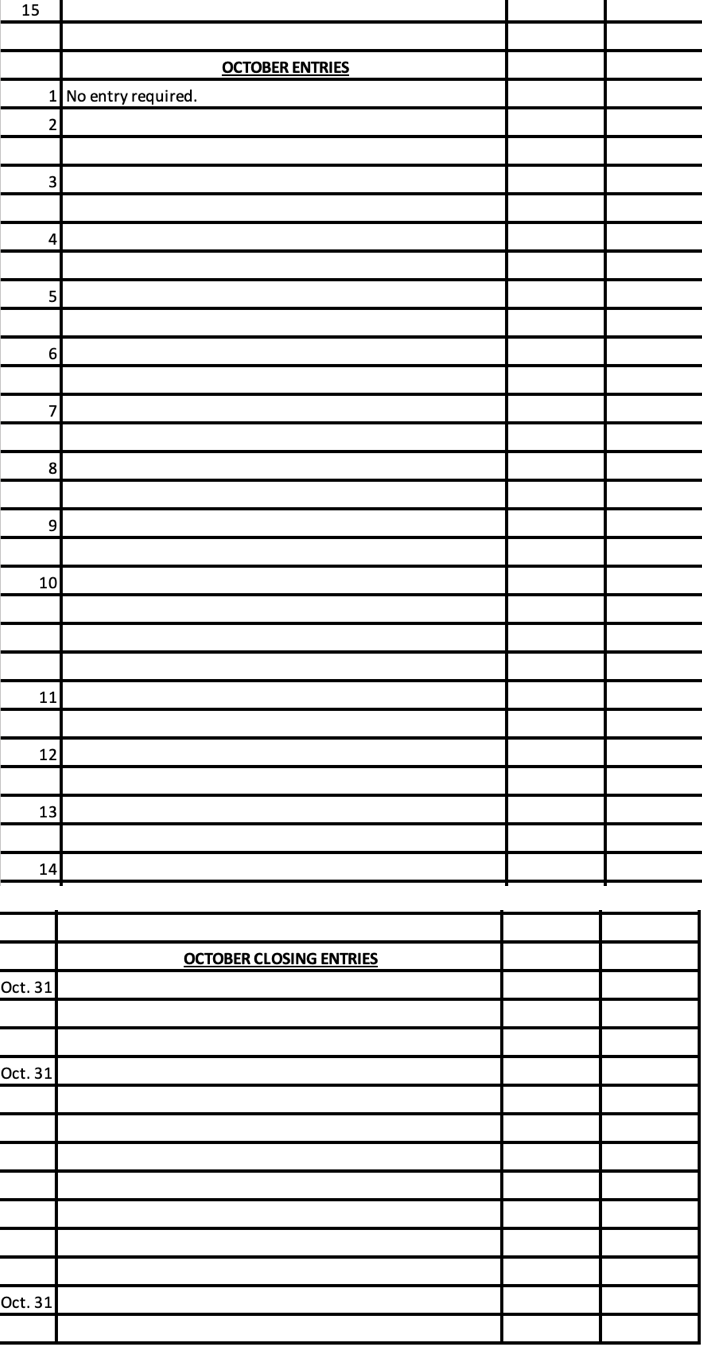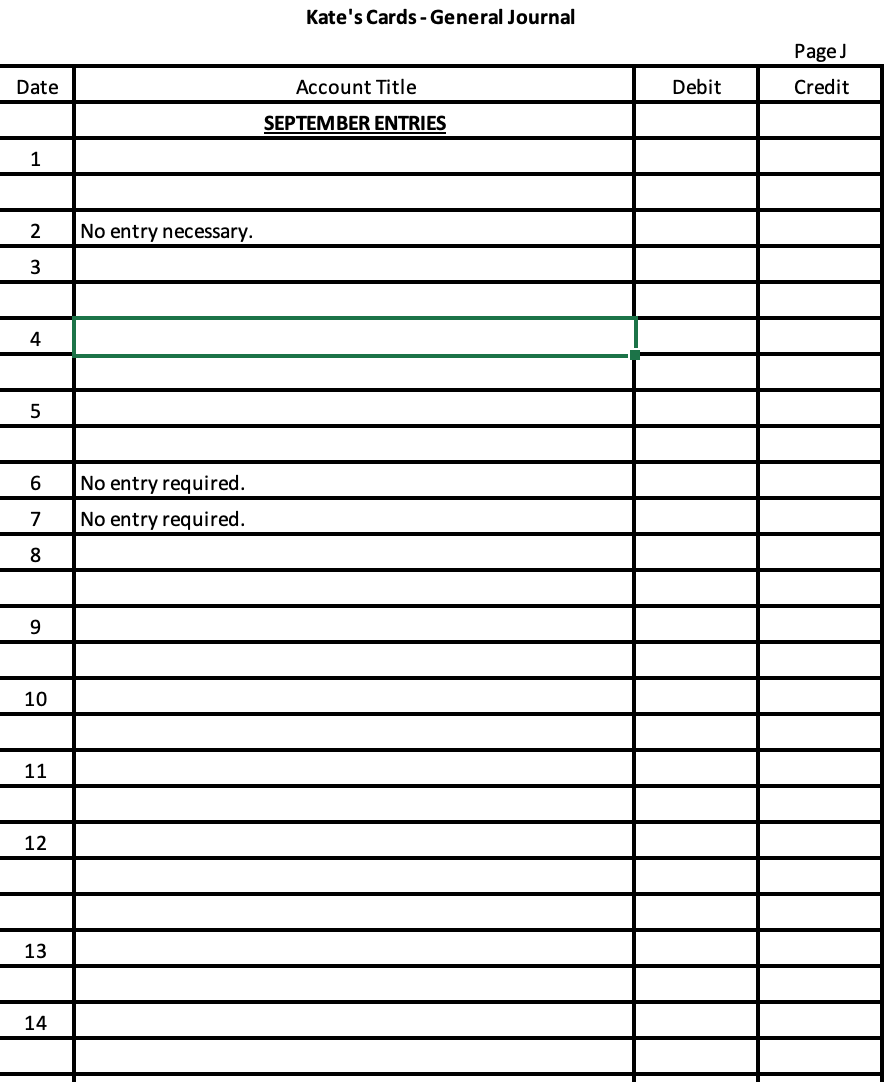Kate Collins has always been good at putting together rhymes for any occasion. Kate is a recent college graduate with a double major in business and art. Kate has always had a bit of an entrepreneurial streak and has decided to open her own business designing and selling greeting cards. Kate decided that she would rent a small studio where she would design the cards on a new Apple iMac that she is planning to purchase. Kate also decided to offer classes in greeting card design to other aspiring greeting card producers. After much thought, Kate decided to name her business “Kate’s Cards.” SEPTEMBER 2019: In September 2019, Kate incorporated Kate’s Cards after investigating different organizational forms, and began the process of getting her business up and running. The following events occurred during the month of September 2019: Kate deposited $10,000 that she had saved into a newly opened business checking account. She received common stock in exchange. Kate designed a brochure that she will use to promote her greeting cards at local stationery stores. Kate paid Fred Simmons $50 to critique her brochure before undertaking her final design and printing. Kate purchased a new iMac computer tablet, specialized graphic arts software, and commercial printer for the company, paying $4,800 in cash. She decided to record all of these items under the same equipment account. Kate purchased supplies such as paper and ink for $350 at the local stationery store. She opened a business account with the store and was granted 30 days credit on all purchases, including the one she just made. Kate designed her first 5 cards and prepared to show them to potential customers. The owner of the stationery store where Kate opened her account was impressed with Kate’s work and ordered 1,000 of each of the five card designs at a cost of $1 per card, or $5,000 total. Kate tells the customer that she will have them printed and delivered within the week. Kate purchased additional supplies, on account, in the amount of $1,500. Kate delivered the 5,000 cards. Because the owner knows that Kate is just starting out, he paid her immediately in cash. He informed her that if the cards sell well that he will be ordering more, but would expect a 30-day credit period like the one he grants to his own business customers. The cost to Kate for the order was $1,750 of the supplies she had purchased. (Hint: This cost should be recorded as a debit to an expense called Cost of Goods Sold.) Kate paid her balance due for the supplies in full. Kate purchased a one-year insurance policy for $1,200, paying the entire amount in cash. (Hint: Two accounts will need to be debited here, one for the current month expense and one for the prepaid amount.) Kate determined that all of her equipment will have a useful life of 4 years (48 months) at which time it will not have any resale or scrap value. (Hint: Kate will expense 1/48th of the cost of the equipment each month to Depreciation Expense. The credit will be to Accumulated Depreciation.) Kate paid herself a salary of $1,000 for the month. Kate paid rent expense for the month in the amount of $1,200. OCTOBER 2019: Getting ready for the upcoming holiday season is traditionally a busy time for greeting card companies, and it was no exception for Kate. The following transactions occurred during the month of October: Hired an assistant at an hourly rate of $10 per hour to help with some of the computer layouts and administrative chores. Supplements her business by teaching a class to aspiring card designers. She charges and receives a total of $450. Delivers greeting cards to several new customers. She bills them a total of $3,500. Pays a utility bill in the amount of $250 that she determines is the business portion of her utility bill. Receives an advance deposit of $500 for a new set of cards she is designing for a new customer. Pays her assistant $200 for the work done this month. Determines that the assistant has worked 10 additional hours this month that have not yet been paid. Ordered and receives additional supplies in the amount of $1,000. These were paid for during the month. Counts her remaining inventory of supplies at the end of the month and determines the balance to be $300. Don’t forget to consider the supplies inventory balance at September 30, from Chapter 2. (Hint: This expense will be a debit to Cost of Goods Sold.) Records the adjusting entries for depreciation and insurance expense for the month. Pays herself a salary of $1,000. Paid monthly rent of $1,200 in cash. Receives her next utility bill during December and determines $85 applies to October’s operations. Deciding she needs a little more cash, Kate pays herself a $100 dividend.
Kate Collins has always been good at putting together rhymes for any occasion. Kate is a recent college graduate with a double major in business and art. Kate has always had a bit of an entrepreneurial streak and has decided to open her own business designing and selling greeting cards. Kate decided that she would rent a small studio where she would design the cards on a new Apple iMac that she is planning to purchase. Kate also decided to offer classes in greeting card design to other aspiring greeting card producers. After much thought, Kate decided to name her business “Kate’s Cards.”
SEPTEMBER 2019:
In September 2019, Kate incorporated Kate’s Cards after investigating different organizational forms, and began the process of getting her business up and running. The following events occurred during the month of September 2019:
- Kate deposited $10,000 that she had saved into a newly opened business checking account. She received common stock in exchange.
- Kate designed a brochure that she will use to promote her greeting cards at local stationery stores.
- Kate paid Fred Simmons $50 to critique her brochure before undertaking her final design and printing.
- Kate purchased a new iMac computer tablet, specialized graphic arts software, and commercial printer for the company, paying $4,800 in cash. She decided to record all of these items under the same equipment account.
- Kate purchased supplies such as paper and ink for $350 at the local stationery store. She opened a business account with the store and was granted 30 days credit on all purchases, including the one she just made.
- Kate designed her first 5 cards and prepared to show them to potential customers.
- The owner of the stationery store where Kate opened her account was impressed with Kate’s work and ordered 1,000 of each of the five card designs at a cost of $1 per card, or $5,000 total. Kate tells the customer that she will have them printed and delivered within the week.
- Kate purchased additional supplies, on account, in the amount of $1,500.
- Kate delivered the 5,000 cards. Because the owner knows that Kate is just starting out, he paid her immediately in cash. He informed her that if the cards sell well that he will be ordering more, but would expect a 30-day credit period like the one he grants to his own business customers.
- The cost to Kate for the order was $1,750 of the supplies she had purchased. (Hint: This cost should be recorded as a debit to an expense called Cost of Goods Sold.)
- Kate paid her balance due for the supplies in full.
- Kate purchased a one-year insurance policy for $1,200, paying the entire amount in cash. (Hint: Two accounts will need to be debited here, one for the current month expense and one for the prepaid amount.)
- Kate determined that all of her equipment will have a useful life of 4 years (48 months) at which time it will not have any resale or scrap value. (Hint: Kate will expense 1/48th of the cost of the equipment each month to
Depreciation Expense. The credit will be to Accumulated Depreciation.) - Kate paid herself a salary of $1,000 for the month.
- Kate paid rent expense for the month in the amount of $1,200.
OCTOBER 2019:
Getting ready for the upcoming holiday season is traditionally a busy time for greeting card companies, and it was no exception for Kate. The following transactions occurred during the month of October:
- Hired an assistant at an hourly rate of $10 per hour to help with some of the computer layouts and administrative chores.
- Supplements her business by teaching a class to aspiring card designers. She charges and receives a total of $450.
- Delivers greeting cards to several new customers. She bills them a total of $3,500.
- Pays a utility bill in the amount of $250 that she determines is the business portion of her utility bill.
- Receives an advance deposit of $500 for a new set of cards she is designing for a new customer.
- Pays her assistant $200 for the work done this month.
- Determines that the assistant has worked 10 additional hours this month that have not yet been paid.
- Ordered and receives additional supplies in the amount of $1,000. These were paid for during the month.
- Counts her remaining inventory of supplies at the end of the month and determines the balance to be $300. Don’t forget to consider the supplies inventory balance at September 30, from Chapter 2. (Hint: This expense will be a debit to Cost of Goods Sold.)
- Records the
adjusting entries for depreciation and insurance expense for the month. - Pays herself a salary of $1,000.
- Paid monthly rent of $1,200 in cash.
- Receives her next utility bill during December and determines $85 applies to October’s operations.
- Deciding she needs a little more cash, Kate pays herself a $100 dividend.
Create a general journal from the entries.


Trending now
This is a popular solution!
Step by step
Solved in 2 steps




